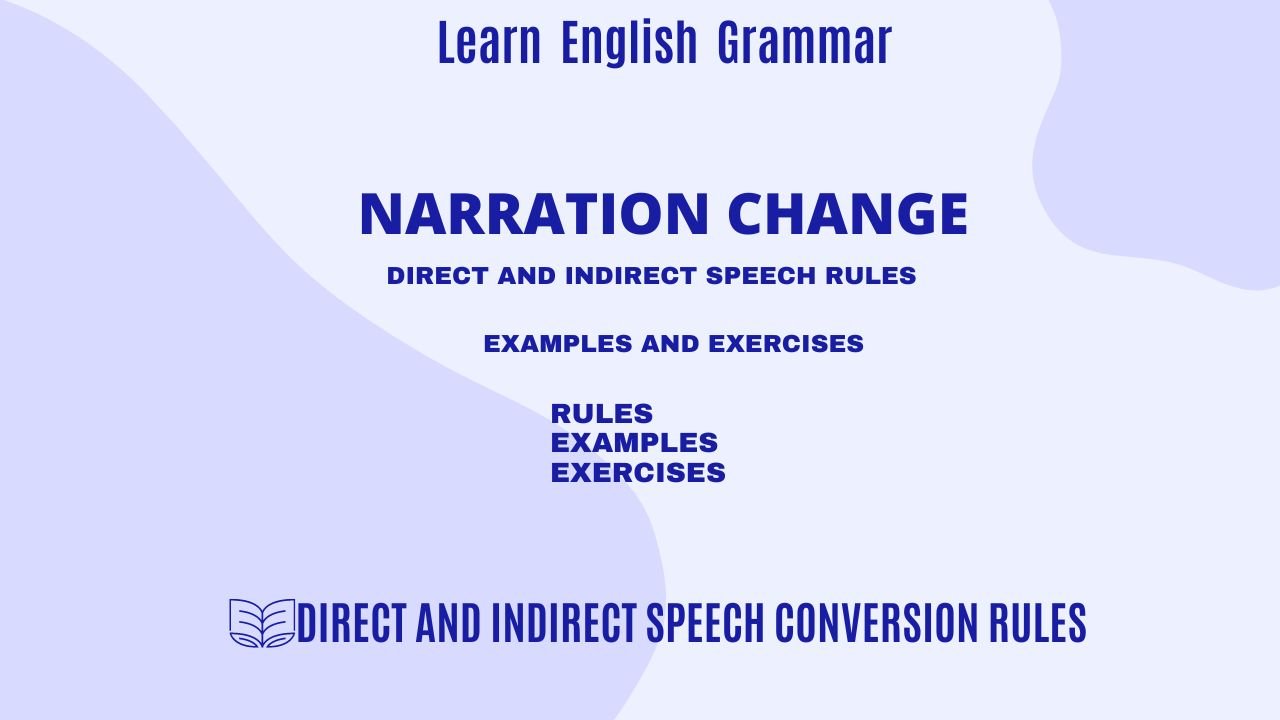

Understanding Direct and Indirect Speech Rules for conversion is crucial for effective communication. This updated guide explains the key rules, including how to choose the right reporting verbs, handle tense changes, and accurately convert speech. With clear examples and practical tips, it’s an ideal resource for students, ESL learners, and exam preparation.
Contents showDirect speech is a form of reporting that presents someone’s exact words without any alterations. It is commonly enclosed in quotation marks.
Direct speech consists of the following elements.
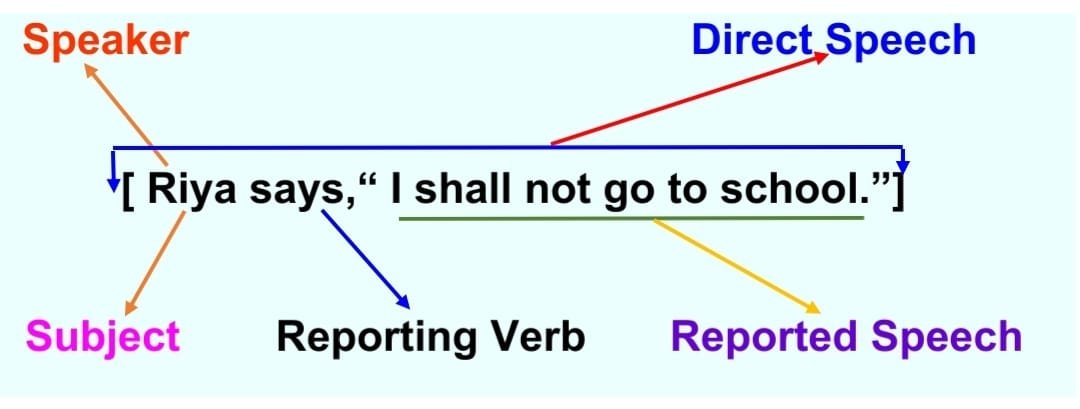
Explanation: “I shall not go to school,” are the exact words of Riya, enclosed in quotation marks/inverted commas (“….”). This format, which uses commas and quotation marks/inverted commas, is called direct speech. In this sentence, ‘Riya’ is the subject or speaker, ‘says’ is the reporting verb, and ‘I shall not go to school’ is the reported speech.
For examples,
People also ask
Indirect speech, on the other hand, involves paraphrasing someone’s words and reporting them indirectly, without using quotation marks. It requires a few changes in structure, such as tense and pronoun.
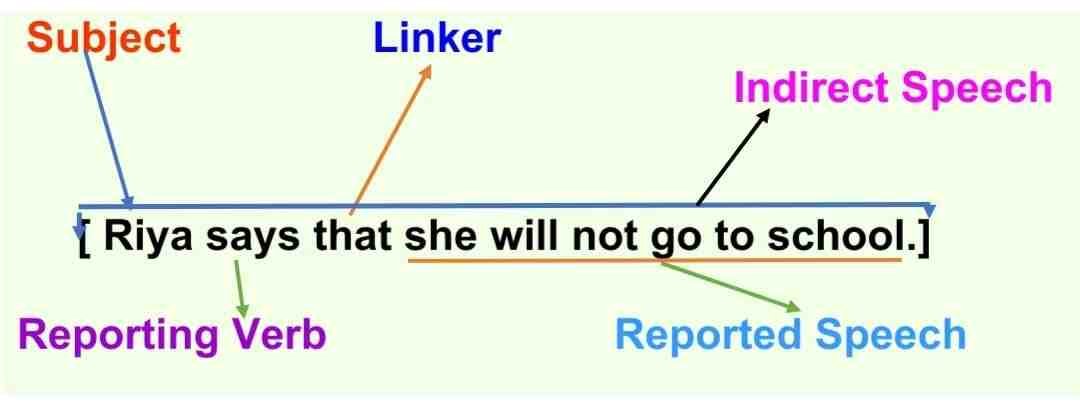
Similarly, we can report the above sentence without quoting Riya’s exact words while keeping the meaning the same. This format is called indirect speech. In this format, no commas or quotation marks/inverted commas are used; only a full stop (.) is used at the end of the sentence.
For examples,
Direct Speech: “We can’t be quite happy in life,” he said.
Indirect Speech: He said that they couldn’t be quite happy in life.
Direct Speech: He said, “The Muslims bury their dead.”
Indirect Speech: He said that the Muslims bury their dead.
Direct Speech: “You’ve overcooked the steak again, Mary”, he said.
Indirect Speech: He told Mary that she had overcooked the steak again.
Direct Speech: Ramen said to Bina, “I’m going to your house this, week.”
Indirect Speech: Ramen told Bina that he was going to her house that week.
Direct Speech: John said, “I am going to the store.”
Indirect Speech: John said that he was going to the store.
Direct Speech: “I can’t believe it,” she whispered, “but I saw a unicorn in the garden.”
Indirect Speech: She whispered that she couldn’t believe it but that she had seen a unicorn in the garden.
The following comparison highlights the key differences between direct and indirect speech rules, including punctuation, tense changes, and adjustments to pronouns and time references.
| Points | Direct Speech | Indirect Speech |
|---|---|---|
| 1. Definition | Quotes the exact words spoken. | Reports the message without quoting exactly. |
| 2. Punctuation | Uses quotation marks (“…”). | No quotation marks are used. |
| 3. Tense | Tense stays the same as originally spoken. | Tense often shifts back (e.g., present to past). |
| 4. Pronouns | Pronouns remain the same. | Pronouns change to fit the reporting perspective. |
| 5. Time References | Time references remain unchanged. | Time references often change (e.g., “today” becomes “that day”). |
| Example 1 | She said, “I am going to the store.” John asked, “Can you help me?” | She said that she was going to the store. John asked if I could help him. |
Discover the essential rules of direct and indirect speech with a variety of examples to improve your language skills. Effortlessly understand the intricacies of converting statements, questions, and commands from one form to another.
“Say” and “tell” are two frequently used reporting verbs. “Say” is generally followed by the reported speech, while “tell” is followed by the indirect object (the person being addressed).
Direct: He says , “I am your friend.”
Indirect: He says that he is your friend.
Direct: He said to me, “I’m going to the store.”
Indirect: She told me that he was going to the store.
| Direct Speech | Indirect Speech |
| say | say |
| say to me | tell me |
| says to them | tells them |
| said | said |
| said to him | told him |
| shall/will say | shall/will say |
| shall/will say to her | shall/will tell her |
When reporting questions, “ask“ and “inquire“ are commonly employed reporting verbs.
Direct: He said to me, “Where are you going?”
Indirect: He asked where I was going.
Direct: She said , “When will the concert start?”
Indirect: She inquired, “When will the concert start?”
Direct: Sarah said , “What time does the movie start?”
Indirect: Sarah asked what time the movie started.
Direct: “Could you please provide more details?” she said to me.
Indirect: She inquired politely if I could provide more details.
Direct: The customer said , “Do you have this item in stock?”
Indirect: The customer i nquired if that item had in stock.
To report imperative sentences, “Request”, “Advise”, “Order”, and “beg” are often used.
Direct: “Please close the door,” she said .
Indirect: She requested that the door be closed.
Direct: “You should study regularly,” he said.
Indirect: He advised that regular studying should be done.
Direct: “Stand up straight,” the sergeant said .
Indirect: The sergeant ordered that they stand up straight.
Direct: He said to me, “Go home at once”
Indirect: He ordered me to go home at once.
Direct: She said , “Do not run in the sun”
Indirect: She advised not to run in the sun.”
Direct: “Please forgive me,” she said.
Indirect: She begged for forgiveness.
If the Reporting Verb is in the Present Tense , there is no change in the tense in the Reported Verb when Direct Speech is converted into Indirect Narration.
Direct: Arnab says , “The room is dark.”
Indirect: Arnab says that the room is dark.
Direct: Arnab says , “The room was dark.”
Indirect: Arnab says that the room was dark.
Direct: Arnab says , “I shall finish the work.”
Indirect: Arnab says that he will finish the work.
Direct: Mary says , “I am going to the party.”
Indirect: Mary says that she is going to the party.
Direct: He tells us, “I will finish the project by tomorrow.”
Indirect: He tells us that he will finish the project by tomorrow.
If the Reporting Verb is in the Future Tense , there is no change in the tense in the Reported Verb when Direct Speech is converted into Indirect Narration.
Direct: Sarah will say , “I am going to the store.”
Indirect: Sarah will say that she is going to the store.
Direct: John will say, “I have completed the assignment.”
Indirect: John will say that he has completed the assignment.
Direct: Arnab will say, “The room is dark.”
Indirect: Arnab will say that the room is dark.
Direct: Arnab will say , “The room was dark.”
Indirect: Arnab will say that the room was dark.
Direct: Arnab will say, “I shall finish the work.”
Indirect: Arnab will say that he will finish the work.
If the Reporting verb of the Direct Narration is in the Past Tense , the Present Tense of the Verb in the Reported Speech of Direct Narration is changed into the corresponding Past Tense in Indirect Narration .
| Reporting Verb | Reported Verb in Direct Speech | Reported speech Verb in Indirect Speech |
| Past Ex: He said, | Present Indefinite ” I love you” | Past Indefinite He said that he loved me. |
| Past Ex: The teacher said, | Universal Truth or Regular Habits ” The sun rises in the east.” | Remains Unchanged The teacher said that the sun rises in the east. |
| Past Ex: She said, | Present Continuous ” I am singing a song.” | Past Continuous She said that she was singing. |
| Past Ex: Mother said, | Present Perfect ” I have finished cooking.” | Past Perfect Mother said that she had finished cooking. |
| Past Ex: Maria said, | Past Indefinite “You did the work.” | Past Perfect Maria said that I had done the work. |
| Past Ex: Soumen said, | Past Continuous ” I was playing football.” | Past Perfect Continuous Soumen said that he had been playing football. |
| Past Ex: Ravvi said, | Past Perfect ” You had insulted me.” | Remains Unchanged Ravi said that I had insulted him. |
| Past Ex: They said, | Shall/Will “We shall help him.” | Should/Would They said that they would help him. |
| Past Ex: Doctor said, | Can / May ” You can do it.” | Could / Might The doctor said that I could do it. |
Direct: Rohan said , “She works hard.”
Indirect: Rohan said that she worked hard.
Direct: Rohan said, “She is singing a song.”
Indirect: Rohan said that she was singing a song.
Direct: The guest said shouting, “We have arrived .”
Indirect: The guest shouted that they had arrived.
Direct: My sister said , “It has been raining hard for 3 days”.
Indirect: My sister said that it had been raining hard for 3 days.
Direct: Father said, “I visited the Taj yesterday.”
Indirect: Father said that he had visited the Taj the previous day.
Direct: The boys said, “They were traveling in the park.”
Indirect: The boys said that they had been traveling in the park.
Direct: The reporters commented , “The Kohinoor had been lost long ago”.
Indirect: The reporters commented that the Kohinoor had been lost long ago.
Direct: Jyotsna said, “ She had been doing the work for 3 hours”.
Indirect: Jyotsna said that she had been doing the work for 3 hours.
The Tense of the Verb remains unchanged in Indirect Narration in cases of General Statements of Facts, Universal Truths, Commonplace Occurrences, and Habitual or Repeated Actions. No real change occurs in these cases. Only there will be present Tense alone.
Direct: The boy said to his mother, “ The sun rises in the East”.
Indirect: The boy told his mother that the sun rises in the East. [ Universal Truth ]
Direct: The monk answered , “ Man is mortal”.
Indirect: The monk answered that man is mortal. [ Universal Truth ]
Direct: The teacher told the students, “ Perseverance always leads to success.”
Indirect: The teacher told the students that perseverance always leads to success.
(a) If the subject of the reported speech of direct form is in the first person, the subject of the reported speech will be replaced by the subject of the reporting verb in indirect form, but the number must be the same. [ singular > singular and plural > plural ]
Examples:
Direct: She says, “ I am ill today.”
Indirect: She says that she is ill that day.
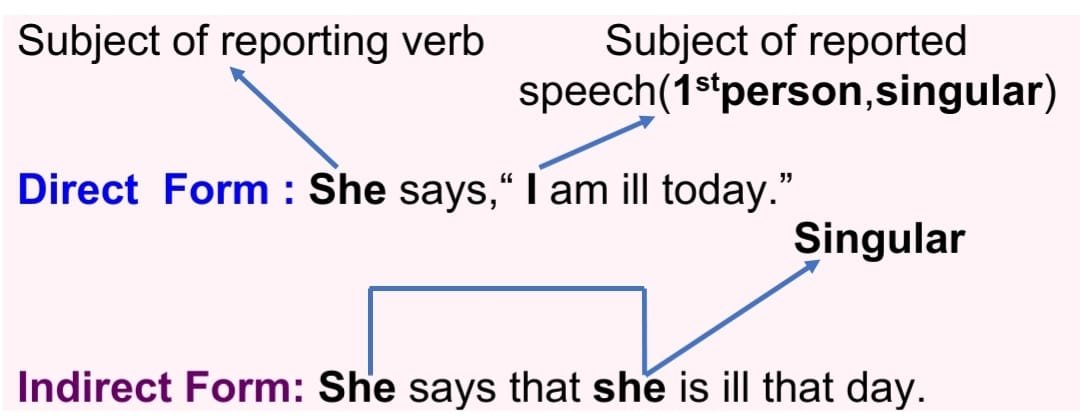
(b) If the subject of the reported speech in the Direct Form is in the second person, the subject of the reported speech will be replaced by the object of the reporting verb in the indirect form, but the number must be the same. [ singular > singular and plural > plural ]
Example:
Direct: He says to me , ” You can do this work.”
Indirect: He tells me that I can do that work.
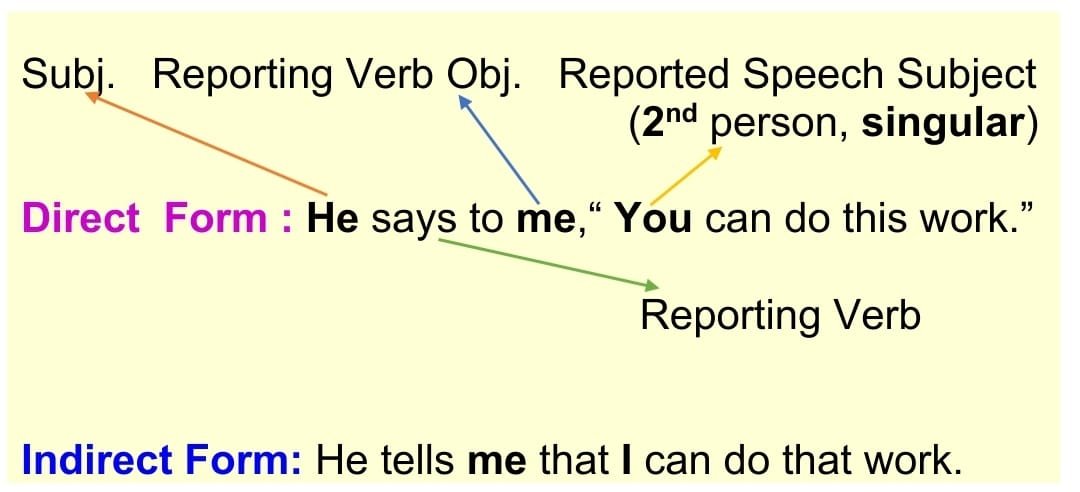
(c) If the subject of the reported speech of Direct Form is in the third person, there will be no change in the person of the Indirect Form.
Direct: I said, “ He will not wait for his friend.”
Indirect: I said that he would not wait for his friend.
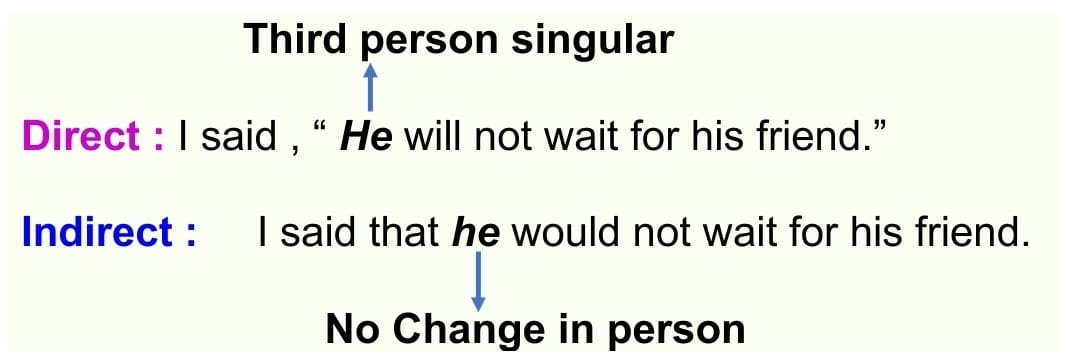
| Subject | Object |
| I (1st person, singular) | me (1st person, singular) |
| We (1st person, plural) | us (1st person, plural) |
| You (2nd person, singular / plural) | You (2nd person, singular / plural) |
| He (3rd person, singular) | him (3rd person, singular) |
| She (3rd person, singular) | her (3rd person, singular) |
| They (3rd person, plural) | them (3rd person, plural) |
In the case of demonstrative pronouns, replace them with appropriate pronouns in indirect speech.
Example:
Direct: “ This is my book,” she said.
Indirect: She said that this was her book.
When introducing indirect speech with a reporting verb, use a comma to separate the reporting verb from the reported speech.
Example: She said, “I’ll be there on time.”
If the direct speech is a question, change the question mark to a full stop when converting to indirect speech.
Example:
Direct: He asked, “Are you coming to the party?”
Indirect: He asked if I was coming to the party.
In cases where the direct speech has an exclamation mark, replace it with a full stop in indirect speech.
Example:
Direct: She exclaimed, “What a beautiful day!”
Indirect: She exclaimed that it was a beautiful day.
When dealing with modals like can, could, will, would, may, might, shall, should, must, etc., use the appropriate past form in indirect speech.
Direct: She said, “You should respect your elders.
Indirect: She said that I should respect my elders.
Direct: She said, “I can speak French fluently.
Indirect: She said that she could speak French fluently.
Direct: May I borrow your pen?” she asked.
Indirect: She asked if she might borrow my pen.
Direct: He said, “You must complete the assignment by tomorrow.
Indirect: He said that I must complete the assignment by the next day.
In indirect speech, conditional sentences undergo specific changes, especially when they involve “will” or “would.”
Direct: He said, “I will help you.”
Indirect: He said that he would help me.
Direct: He said, “I will help you with your project
Indirect: He said that he would help me with my project.
When using adverbs of time in indirect speech, adjust them to match the new timeframe.
Example:
Direct: “I will come tomorrow,” she said.
Indirect: She said that she would come the next day.
Similar to adverbs of time, adverbs of place need modification in indirect speech.
Example:
Direct: ” I live here,” he said.
Indirect: He said that he lived there.
We can also use Adverbs of manner in indirect speech, requiring appropriate adjustments.
Example:
Direct: “He ran quickly,” she said.
Indirect: She said that he ran quickly.
In Indirect Narration, words denoting Time, Place, Manner, Distance, and Direction used in the quoted speech are correspondingly changed to conform to the point of view of the Reporter. Thus, the sense of nearness is changed into that of Distance, and so on.